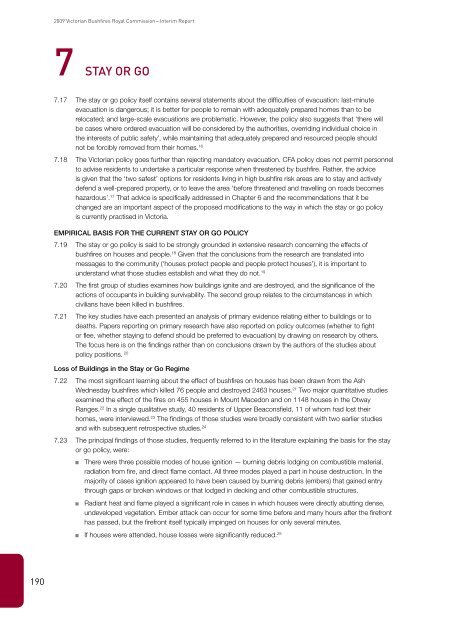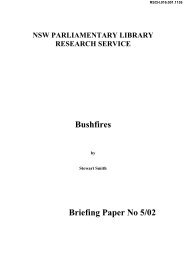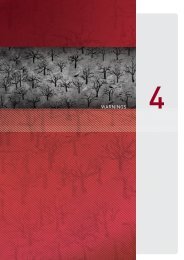Chapter 7 - Stay or go - 2009 Victorian Bushfires Royal Commission
Chapter 7 - Stay or go - 2009 Victorian Bushfires Royal Commission
Chapter 7 - Stay or go - 2009 Victorian Bushfires Royal Commission
Create successful ePaper yourself
Turn your PDF publications into a flip-book with our unique Google optimized e-Paper software.
<strong>2009</strong> Vict<strong>or</strong>ian <strong>Bushfires</strong> <strong>Royal</strong> <strong>Commission</strong>—Interim Rep<strong>or</strong>t<br />
7 <strong>Stay</strong> <strong>or</strong> Go<br />
7.17<br />
7.18<br />
The stay <strong>or</strong> <strong>go</strong> policy itself contains several statements about the difficulties of evacuation: last-minute<br />
evacuation is dangerous; it is better f<strong>or</strong> people to remain with adequately prepared homes than to be<br />
relocated; and large-scale evacuations are problematic. However, the policy also suggests that ‘there will<br />
be cases where <strong>or</strong>dered evacuation will be considered by the auth<strong>or</strong>ities, overriding individual choice in<br />
the interests of public safety’, while maintaining that adequately prepared and resourced people should<br />
not be f<strong>or</strong>cibly removed from their homes. 16<br />
The Vict<strong>or</strong>ian policy <strong>go</strong>es further than rejecting mandat<strong>or</strong>y evacuation. CFA policy does not permit personnel<br />
to advise residents to undertake a particular response when threatened by bushfire. Rather, the advice<br />
is given that the ‘two safest’ options f<strong>or</strong> residents living in high bushfire risk areas are to stay and actively<br />
defend a well-prepared property, <strong>or</strong> to leave the area ‘bef<strong>or</strong>e threatened and travelling on roads becomes<br />
hazardous’. 17 That advice is specifically addressed in <strong>Chapter</strong> 6 and the recommendations that it be<br />
changed are an imp<strong>or</strong>tant aspect of the proposed modifications to the way in which the stay <strong>or</strong> <strong>go</strong> policy<br />
is currently practised in Vict<strong>or</strong>ia.<br />
EMPIRICAL BASIS FOR THE CURRENT STAY OR GO POLICY<br />
7.19 The stay <strong>or</strong> <strong>go</strong> policy is said to be strongly grounded in extensive research concerning the effects of<br />
bushfires on houses and people. 18 Given that the conclusions from the research are translated into<br />
messages to the community (‘houses protect people and people protect houses’), it is imp<strong>or</strong>tant to<br />
understand what those studies establish and what they do not. 19<br />
7.20<br />
7.21<br />
The first group of studies examines how buildings ignite and are destroyed, and the significance of the<br />
actions of occupants in building survivability. The second group relates to the circumstances in which<br />
civilians have been killed in bushfires.<br />
The key studies have each presented an analysis of primary evidence relating either to buildings <strong>or</strong> to<br />
deaths. Papers rep<strong>or</strong>ting on primary research have also rep<strong>or</strong>ted on policy outcomes (whether to fight<br />
<strong>or</strong> flee, whether staying to defend should be preferred to evacuation) by drawing on research by others.<br />
The focus here is on the findings rather than on conclusions drawn by the auth<strong>or</strong>s of the studies about<br />
policy positions. 20<br />
Loss of Buildings in the <strong>Stay</strong> <strong>or</strong> Go Regime<br />
7.22<br />
7.23<br />
The most significant learning about the effect of bushfires on houses has been drawn from the Ash<br />
Wednesday bushfires which killed 76 people and destroyed 2463 houses. 21 Two maj<strong>or</strong> quantitative studies<br />
examined the effect of the fires on 455 houses in Mount Macedon and on 1148 houses in the Otway<br />
Ranges. 22 In a single qualitative study, 40 residents of Upper Beaconsfield, 11 of whom had lost their<br />
homes, were interviewed. 23 The findings of those studies were broadly consistent with two earlier studies<br />
and with subsequent retrospective studies. 24<br />
The principal findings of those studies, frequently referred to in the literature explaining the basis f<strong>or</strong> the stay<br />
<strong>or</strong> <strong>go</strong> policy, were:<br />
■■<br />
■■<br />
■■<br />
There were three possible modes of house ignition — burning debris lodging on combustible material,<br />
radiation from fire, and direct flame contact. All three modes played a part in house destruction. In the<br />
maj<strong>or</strong>ity of cases ignition appeared to have been caused by burning debris (embers) that gained entry<br />
through gaps <strong>or</strong> broken windows <strong>or</strong> that lodged in decking and other combustible structures.<br />
Radiant heat and flame played a significant role in cases in which houses were directly abutting dense,<br />
undeveloped vegetation. Ember attack can occur f<strong>or</strong> some time bef<strong>or</strong>e and many hours after the firefront<br />
has passed, but the firefront itself typically impinged on houses f<strong>or</strong> only several minutes.<br />
25<br />
If houses were attended, house losses were significantly reduced.<br />
190
















